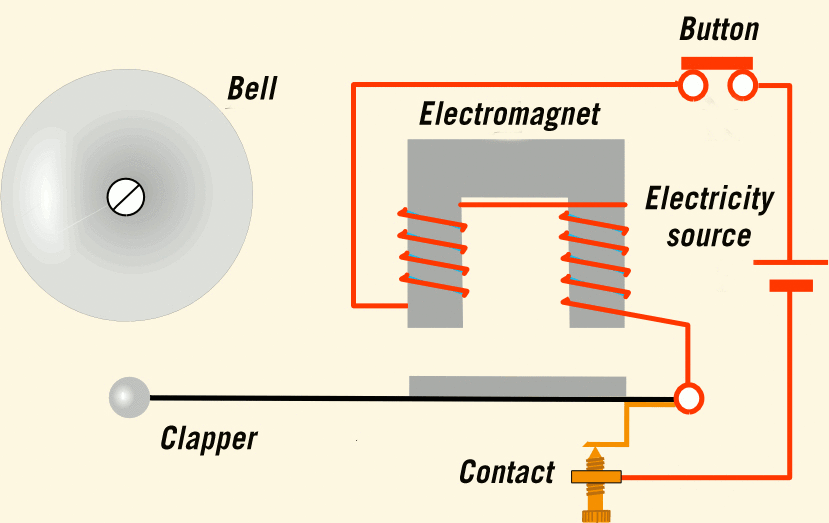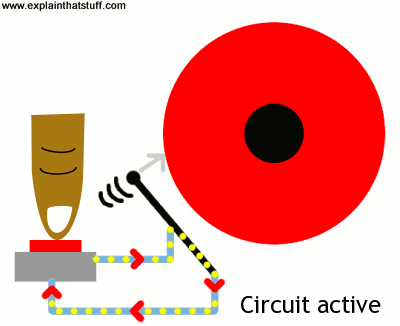Understanding How Doorbells Function

A doorbell works by utilizing a transformer and solenoid in conjunction with electromagnetism to produce sound or light when the switch is activated.
In wired doorbells, pressing the button completes an electrical circuit, sending current through wires to a terminal that activates a bell or chime, creating a "ding" doorbell sound.
Wireless doorbells use radio signals to trigger the door bell sound. The electrical system might include a light to indicate that the signal has been received.
Whether it's the wonder of a traditional bell or a more modern sound mechanism, understanding doorbells involves knowing how the push switch, wire, and circuit work together. If any component fails, you may need to replace it to ensure the doorbell continues to function properly.

How does an electric wired doorbell work?
An electric wired doorbell works by utilizing an electrical circuit that is activated when the doorbell button is pushed. When you push the switch, current flows through the circuit, allowing power to reach the chimes or bell, producing the familiar "ding" or "ring" sound you hear.
Some electronic doorbells also feature a light that activates to signal that the push of the button has been registered. This system is typically powered by a battery or connected to the household's electrical wiring.
If you ever wonder what happens when the doorbell is pressed, note that the flow of electricity through the wire is what triggers the sound mechanism. Additionally, keeping a doorbell in good working order is important for home security, and it may require occasional maintenance or replacement.

How a doorbell works?: Electromagnetic Principle
A doorbell works when you press the doorbell button, completing an electrical circuit that allows current to flow through a transformer. This activates a solenoid with an iron core, producing the sound of chimes or bells.
Inside a wired electronic doorbell, the button acts as a switch that temporarily allows power from a transformer to move through a circuit.
The transformer is crucial as it steps down the higher voltage from your home’s main power supply to the lower voltage needed for the doorbell system.
Once the circuit is completed, either a solenoid or an electromagnet is activated, pulling a metal striker/ hammer to hit the bell or creating the familiar "ding dong" chime you hear.
In wireless doorbells, the push of the button sends a signal to a receiver via a transmitter. The receiver, which can be powered by batteries or an electronic power source, then activates the sound mechanism, which could be an electronic chime or a recording of a bell. Wireless doorbell offers flexibility in installation since they don't require extensive wiring.
Some of the most powerful magnets in the world reside in scientific laboratories and research facilities. These electromagnetic marvels are crucial for various technological and medical advancements.

How does an electric doorbell work?: Doorbell Physics
An electric doorbell works by utilizing an electrical circuit to create sound, often characterized by the familiar "ding dong" chime.
When the doorbell button is pressed, it closes the circuit, allowing current to flow from the transformer through the wires toward the doorbell chime unit.
This action generates a magnetic field within the iron core solenoid, pulling a striker/ hammer to hit the two tone bars or bells, creating the distinct ringing sound. The transformer reduces the high voltage from the main power supply to a safer lower voltage suitable for the doorbell system.
An electric door bell typically consists of several key components: the button, the transformer, a solenoid with an iron core, and the chime or bell unit.
The button, often located at the front door or back door, acts as a switch to trigger the circuit. Upon pressing, it allows the current to travel from the transformer's secondary terminals, through the solenoid, and to the chimes, creating sound.
Electric bells are commonly used not just in residential entryways with wired doorbells, but also in various scenarios like schools, public buildings, and smart doorbells. Smart doorbells, in particular, integrate advanced signal transmitters and lights, further enhancing their utility.
In summary, doorbells work through a harmonic play between electric current, magnetic fields, and mechanical movement, culminating in the pleasant chimes we hear when someone is at the door.

How does a doorbell work?: Doorbell Wiring Diagram
A doorbell works when you press the doorbell (switch). When the doorbell button is pressed, which can either be wired or wireless; current is allowed to flow through the solenoid, allowing the solenoid to generate a strong magnetic field which can then exhibit a strong magnetic force on the iron rod pulling it towards the bell/ chime machine and causing it to strike the bell/ chime.
A single doorbell wiring diagram typically involves a series of connections between the doorbell button, the transformer, and the chimes or bell itself. In a wired doorbell system, two wires connect the doorbell button to the transformer and then to the chime unit. The pressing of the doorbell button completes the circuit, causing the chime to sound a "ding dong" noise.
For a ring doorbell wiring diagram, the setup may involve more complex connections with a smart doorbell system that can be integrated with your phone to alert you when someone is at the door. These systems often include additional features like video and audio capabilities.
A simple doorbell circuit diagram shows the basic connections necessary for the doorbell to function, often involving just the button, the transformer, and the chime unit.
Older doorbell systems typically use four wires. These systems often run on an AC 240V power supply and use a transformer, with the extra wires allowing for more complex chime patterns or additional features by connecting different parts of the chime unit.
In contrast, newer, battery-powered doorbells usually utilize just two wires. These simpler systems are often powered by AAA batteries and may include additional components like a light or solenoid to enhance functionality.
Regardless of the system, the basic principle remains the same: pressing the doorbell button completes the circuit, triggering the chime or bell to alert the occupants.

How does an electric doorbell work?: Electric Doorbell Animation
An electric doorbell works by utilizing electromagnetism to produce sound. When the doorbell button is pressed, it closes a circuit, allowing electrical current to flow from the power source through the system.
This current flows through a transformer, which adjusts the voltage to the required level for the doorbell. The current then moves through a set of wires connected to the terminals of a solenoid.
The solenoid, which contains a coil of wire and an iron core, becomes magnetized when the current flows through it, turning it into an electromagnet.
This electromagnetism triggers the iron core to move, causing a mechanical action that strikes the bell, producing the familiar "ding dong" sound.
Once the button is released, a spring pushes the iron core back to its original position, ready for the next activation. In a wired doorbell system, the components are connected by means of two wires running from the doorbell button to the transformer and solenoid.
In some systems, a light can also be connected to indicate when the button is pressed. This process demonstrates how doorbells work, leveraging principles of electromagnetism and mechanical motion to alert occupants of someone at the door.

Where does a doorbell get its power from?
A doorbell gets its power from the home's electrical system through a transformer, which steps down the high voltage electricity to a safer level suitable for the bell.
In wired doorbells, pressing the doorbell button completes the circuit, allowing electricity to flow through two wires that connect to the doorbell's terminals.
This triggers the bell to ring, producing the familiar chime at the front door. The switch mechanism in the doorbell press is simple yet efficient, ensuring that the circuit is completed each time it is pressed.
The transformer plays a crucial role in this process by converting the household's high voltage to a lower, manageable voltage for the doorbell system. In contrast, wireless doorbells use batteries and radio signals to achieve the same effect without needing a direct electrical connection.
Wireless doorbells are available as smart video doorbell cameras. Here's how to choose the best smart video doorbell camera for you.
Whether wired or wireless, the interaction between electricity and the doorbell circuit is fundamental to generating the doorbell sounds heard when someone is at the door.
Additionally, a circuit breaker ensures safety by interrupting the flow of electricity in case of any overload or fault in the system, protecting both the doorbell and the home's electrical infrastructure.

How does a doorbell make sound?: Doorbell chime sound
A doorbell produces sound by using the magnetic field from an electromagnet to activate a mechanism that rings the chime.
When the ring button is pressed, an electric current flows through the wire, activating the solenoid in the electromagnet.
This magnetic field attracts a metal striker/ hammer, which strikes a bell or two tone sound plate, producing the familiar "ding dong" sound.
The button press triggers this process, causing the striker/ hammer to hit the chimes in succession, resulting in the ringing sound we hear. The doorbell chime relies on this precise flow of electric current and magnetic force to signal someone’s presence effectively.
If your doorbell isn't producing any sound or chime, it might be faulty. Discover the reasons your doorbell is not working.

Does a doorbell work without electricity?
Yes, a doorbell works without electricity. When it comes to modern wireless doorbells, which operate on batteries and do not require a transformer.
These systems are designed to function independently of the home's traditional electrical system, making installation simpler and more versatile.
Wireless doorbells come with an internal battery that powers the entire system, eliminating the need to connect wires throughout the house.
When the doorbell button is pressed, a signal is transmitted from the button to the chime unit, which is connected to the internal battery.
This process triggers the sound mechanism, often mimicking the traditional chime sound without the need for direct electrical current or high voltage.
Smart doorbells often enhance this by incorporating additional features like video cameras and smartphone connectivity, enabling users to see and speak with visitors remotely.
Thus, the role of the transformer in providing necessary power and converting voltages becomes obsolete in these modern systems, creating a more flexible and user-friendly solution for home security and convenience.

Is it safe to touch doorbell wires?: Wired doorbells safety
Yes, it is safe to touch doorbell wires, as wired doorbells typically operate on low voltage, which minimizes the risk of shock.
The electricity flowing through these wires is usually around 16 to 24 volts, significantly lower than the standard house voltage of 120 to 240 volts.
When replacing or handling doorbell components, ensure power is turned off to eliminate any risk entirely.
Although the low voltage makes it safer, caution should still be observed, as improper handling can lead to minor shocks or damage to the wiring.
Always double-check power sources and follow safety guidelines to ensure the process of replacing or working with doorbell wires is completely secure.
Doorbell wires need to be correctly connected to the switch. Considering changing your doorbell and switch? Contact Lito Electrical Service on doorbell installation! Learn how to replace doorbell switch here.